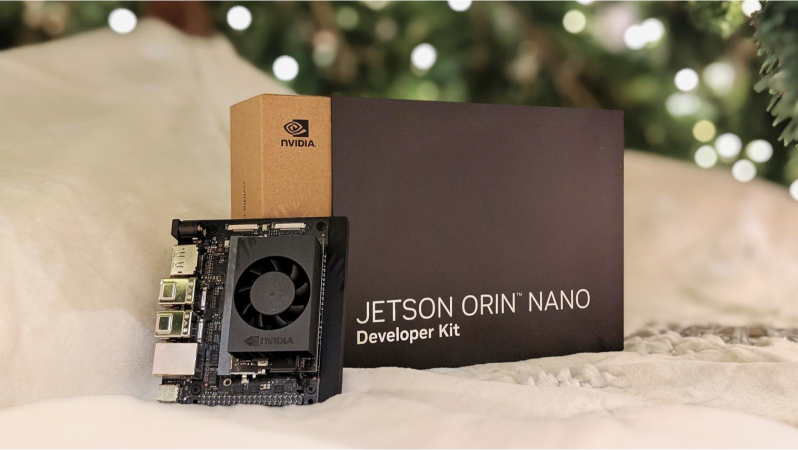Jetson Orin Nano Super Dev Kit


Published on
NVIDIA has released something that should be on every developer's radar: the Jetson Orin Nano Super Developer Kit. At $249, it's like finding that perfect development board that actually delivers on its promises – except this one runs CUDA and makes your AI models 70% faster.
The Executive Summary
Let me break down what makes this little board special:
- Price: $249 (your wallet just breathed a sigh of relief)
- Performance: Up to 70% faster with the new 25-watt "Super" mode
- Support: Extended through 2032 (longer than most of us keep our New Year's resolutions)
- Memory: 8GB LPDDR5 with 102 GB/s throughput in Super mode
And here's the best part for those of you with the regular Orin Nano: yes, you can upgrade to Super status with a software update. It's like finding out your sedan secretly had a turbo button all along.
What's Actually in the Box?
Opening the Jetson Orin Nano Super is straightforward. You get three main components that fit together like expensive LEGO blocks:
- The plastic base holds the antennas and keeps everything off your desk.
- The carrier board is where all the I/O magic happens.
- The Jetson module contains all the compute power.
Technical Specs
Let's talk about what's under the hood. The Tegra Orin system-on-chip is the star of the show, packing everything into one efficient package. Here's what you're working with:
The CPU brings six ARM Cortex-A78 cores to the party, backed by 1.5MB of L2 cache and 4MB of L3 cache. But let's be honest – you're not buying this for the CPU. The GPU is where things get interesting: 1,024 CUDA cores and 32 third-generation tensor cores, all built on NVIDIA's Ampere architecture. This isn't just marketing speak; it's the difference between your model training while you grab coffee versus while you binge-watch an entire season on Netflix.
The 8GB of LPDDR5 memory might not sound like much in our era of 64GB desktop builds, but remember – this is low-power memory that's 25% faster than the previous generation. In the new Super mode, you're looking at 102 GB/s of memory bandwidth. That's enough to keep those tensor cores fed and happy.
Power Profiles
The Orin Nano Super gives you three power profiles to play with:
- 7-watt mode: For when you're running on battery and need to stretch every electron
- 15-watt mode: The balanced option, like ordering a medium coffee
- 25-watt Super mode: Full send – this is where you get that 70% performance boost
The ability to switch between these modes means you can prototype at full power on your bench, then dial it back for deployment in your autonomous coffee-fetching robot.
I/O Connectivity
The carrier board is generous with its I/O options. You've got four USB 3.2 Gen 2 ports (because who doesn't have at least four things to plug in?), Display Port for when you need to show off your work, Gigabit Ethernet for serious data transfer, and a USB-C port for... well, everything else.
For the makers and tinkerers, there's a 40-pin GPIO header in the familiar Raspberry Pi layout. This means all those sensors and gadgets you've been hoarding finally have a purpose. The board also includes two MIPI CSI-2 camera connectors – perfect for computer vision projects that need stereo input or just can't decide which angle looks best.
Under the board, you'll find M.2 slots for both wireless (pre-installed) and NVMe storage. The 2280 M.2 slot supports four PCIe Gen 3 lanes, so you can add some serious storage if your models need it.
Software
JetPack 6.1 comes loaded with everything you'd expect from NVIDIA's ecosystem. You get TensorRT for optimizing your models, DeepStream for video analytics, the Isaac SDK for robotics, and OpenCV for when you need to detect whether that's a hot dog or not a hot dog.
The real gem is the NVIDIA Jetson AI Lab – think of it as Stack Overflow meets GitHub, but specifically for Jetson AI projects. There are tutorials, benchmarks, and enough example projects to keep you busy for months.
Real-World Performance
Running Llama 3.2 (the 3-billion parameter version) on the Jetson Orin Nano Super is surprisingly snappy. Token generation is fast enough that you won't be drumming your fingers waiting for responses. The model uses about 72% of available memory, which is the sweet spot – enough headroom to avoid swapping, but not so much that you're wasting resources.
Want to run a 7-billion parameter model? It's possible, but you'll need to get creative with quantization and memory management. Think of it as the difference between a comfortable road trip and cramming everyone into a compact car – doable, but requires some planning.
Should You Buy It?
At $249, the Jetson Orin Nano Super hits a sweet spot for developers who want to experiment with edge AI without taking out a second mortgage. If you're building prototypes for robotics, computer vision, or edge AI applications, this board gives you enough power to validate your ideas before moving to production hardware.
For those already in the Jetson ecosystem with an Orin Nano, the free software upgrade to Super status is like finding twenty bucks in your jacket pocket – unexpected and delightful.
The Bottom Line
The Jetson Orin Nano Super is NVIDIA's way of democratizing edge AI development. It's powerful enough to run modern AI models, affordable enough that you won't have to explain the purchase to your significant other, and supported long enough that you'll actually get to finish that project you've been planning.
Whether you're building the next generation of smart cameras, training robots to navigate your cluttered garage, or just want to run LLMs without cloud dependency, the Orin Nano Super gives you a legitimate development platform that won't break the bank.
Now if you'll excuse me, I have a robot to teach about the difference between Border Collies and Dachshunds because apparently, that's what we do with our edge AI devices now. Happy hacking!